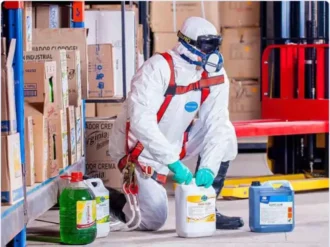Introduction
In-home caregivers fulfil an essential role for elderly people who struggle with daily living activities. As they assume responsibility for one or several seniors, such employees must also take good care of themselves while performing their duties. In order to avoid possible accidents, caregivers must receive proper safety training prior to their first tasks.
Potential Hazards
The most common risks associated with caregiving include:
Exposure to Infectious Diseases.
Due to the nature of their work, caregivers can be exposed to a wide range of infectious and contagious diseases. While some bacteria and viruses are airborne, others can be transmitted through bodily fluids and even hand-to-hand contact. Common tasks such as changing diapers, performing first aid, administering injections, or washing another person must be performed with great care so as to avoid accidents such as needlesticks that can lead to serious illnesses.Exposure to Dangerous Chemicals.
Caregiving employees are usually tasked with more than the supervision of seniors and/or children. They must perform kitchen work, clean and sanitize the house, as well as do the laundry, amongst other things. While working with cleaning products and disinfectants, in particular, caregivers may be exposed to dangerous chemicals. The ingestion of such substances and the inhalation of vapors can lead to difficulty in breathing, allergies, and even lung disease.Electrical and Fire Accidents.
While carrying out routine housekeeping tasks, employees must be wary of the risk of electrocution and fire. For example, a caregiver might be required to change a broken lightbulb, but should not attempt to do so unless they are able to safely cut off the power to the bulb and use a ladder to replace it. In addition, employees might experience burns while working with deep fryers, ovens, and steaming pots in the kitchen. If left unsupervised, a gas stove can lead to a fire or the flame could be put out while the gas is still running.Ergonomic Hazards.
Caregivers work long hours, often alone. During their shifts, they are usually required to help others get out of bed, move around the house, and/or perform other tasks such as washing. This can take a toll on the caregiver’s body, especially as far as the back, neck, and shoulders are concerned. To avoid musculoskeletal injuries, employees must learn proper lifting techniques and allow themselves to rest whenever they feel fatigue or pain.
Incident Prevention
Fortunately, the majority of accidents in caregiving are entirely preventable if employees are properly trained to recognize, assess, and avoid common risks. Given that caregivers are responsible not just for their own safety, but for that of their clients as well, safety training is of paramount importance.
For example, bloodborne pathogens constitute one of the most dangerous hazards associated with caregiving, but exposure can be avoided altogether if the right protective equipment is used. In addition, employees who must also administer injections or other medication should be trained to use needles, as well as handle medicine in a safe manner. When dealing with biohazards, the disposal of dangerous must also be done with great care.
Finally, housekeeping employees must learn how to handle fire and electricity during quotidian tasks. Otherwise, if a caregiver is not familiar with the necessary steps to changing a light bulb or fixing and electrical appliance, they should call a professional electrician to avoid unwanted incidents. Caregivers must keep emergency phone numbers in reach at all times and have a basic grasp of first aid techniques in case the emergency personnel are unable to respond in due time.
Recommended Safety Courses



What You Can Do to Stay Safe
Although caregiving is not one of the most dangerous professions in Canada, employees working in this sector are nevertheless exposed to a set of hazards that can put their life and health at risk. As a caregiver, you have the right to learn about the most common hazards associated with your job. Furthermore, across all Canadian jurisdictions, it is the responsibility of your employer to ensure that you have access to the necessary safety courses.
For a comprehensive list of training programs most suitable for caregiving, please visit our Pharmaceuticals and Healthcare industry page.

